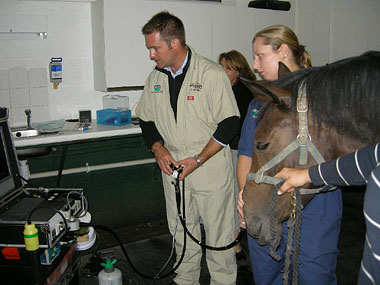Gastric Ulcers: Still A Long Way To Go
 10 years ago
10 years ago  1969 views
1969 views
Posted
5th November, 2013 20h55
 Richard Hepburn performing a gastroscopy
Despite the huge increase in the diagnosis and treatment of equine gastric ulcers it is still believed that many horses go undiagnosed.
A recent Merial survey of equine vets has shown that in just six years the number of practices owning a scope has more than doubled, and half of equine practices now own a scope. Over the same period the average number of monthly scopes has risen from 1.5 to 9.25 and referrals from practices without a scope has risen by 65%.
Merial’s Louise Radford MRCVS explains: “The survey also showed that symptom recognition among vets prompting the need for an endoscopy has also risen. The vast majority of vets now consider changes in behaviour, loss of appetite and poor performance as potential signs. In addition, 100% of those surveyed would consider an endoscopy when presented with the signs of recurring colic.
“However whilst this is great progress, when diagnosis is compared to the incidence of ulcer, we know that more needs to be done. It is believed that up to 30% of leisure horses have some degree of gastric ulceration, and this increases in sports horses, yet just a fraction of this figure represents those scoped,” she adds.
Richard Hepburn BVSc MS(Hons) CertEM(IntMed) DipACVIM(LA) MRCVS, American and RCVS Specialist in Equine Internal Medicine at B&W Equine Hospital is pleased that more horses are being scoped for gastric ulcers but says that further education is needed. “We’ve seen a huge leap in the appreciation of the incidence of gastric ulceration in non-racing animals, which long term will better our understanding of the individual clinical relevance of particular lesions, and the benefits of treatment and management change.
“This should improve both performance and horse welfare, as well as increasing client satisfaction,” adds Mr Hepburn.
Richard Hepburn performing a gastroscopy
Despite the huge increase in the diagnosis and treatment of equine gastric ulcers it is still believed that many horses go undiagnosed.
A recent Merial survey of equine vets has shown that in just six years the number of practices owning a scope has more than doubled, and half of equine practices now own a scope. Over the same period the average number of monthly scopes has risen from 1.5 to 9.25 and referrals from practices without a scope has risen by 65%.
Merial’s Louise Radford MRCVS explains: “The survey also showed that symptom recognition among vets prompting the need for an endoscopy has also risen. The vast majority of vets now consider changes in behaviour, loss of appetite and poor performance as potential signs. In addition, 100% of those surveyed would consider an endoscopy when presented with the signs of recurring colic.
“However whilst this is great progress, when diagnosis is compared to the incidence of ulcer, we know that more needs to be done. It is believed that up to 30% of leisure horses have some degree of gastric ulceration, and this increases in sports horses, yet just a fraction of this figure represents those scoped,” she adds.
Richard Hepburn BVSc MS(Hons) CertEM(IntMed) DipACVIM(LA) MRCVS, American and RCVS Specialist in Equine Internal Medicine at B&W Equine Hospital is pleased that more horses are being scoped for gastric ulcers but says that further education is needed. “We’ve seen a huge leap in the appreciation of the incidence of gastric ulceration in non-racing animals, which long term will better our understanding of the individual clinical relevance of particular lesions, and the benefits of treatment and management change.
“This should improve both performance and horse welfare, as well as increasing client satisfaction,” adds Mr Hepburn. More from
- IVC Evidensia assembles expert team to run new £10m referral hospital
- Home delivery service can increase pet health plan sign-ups by 25%
- Research reveals vital clues to help fight anthelmintic resistance
- Lifetime Achievement Award recognises Harrogate vet’s dedication to improving the health and welfare of rabbits
- Bake sale at Leicestershire vet practice for good cause

